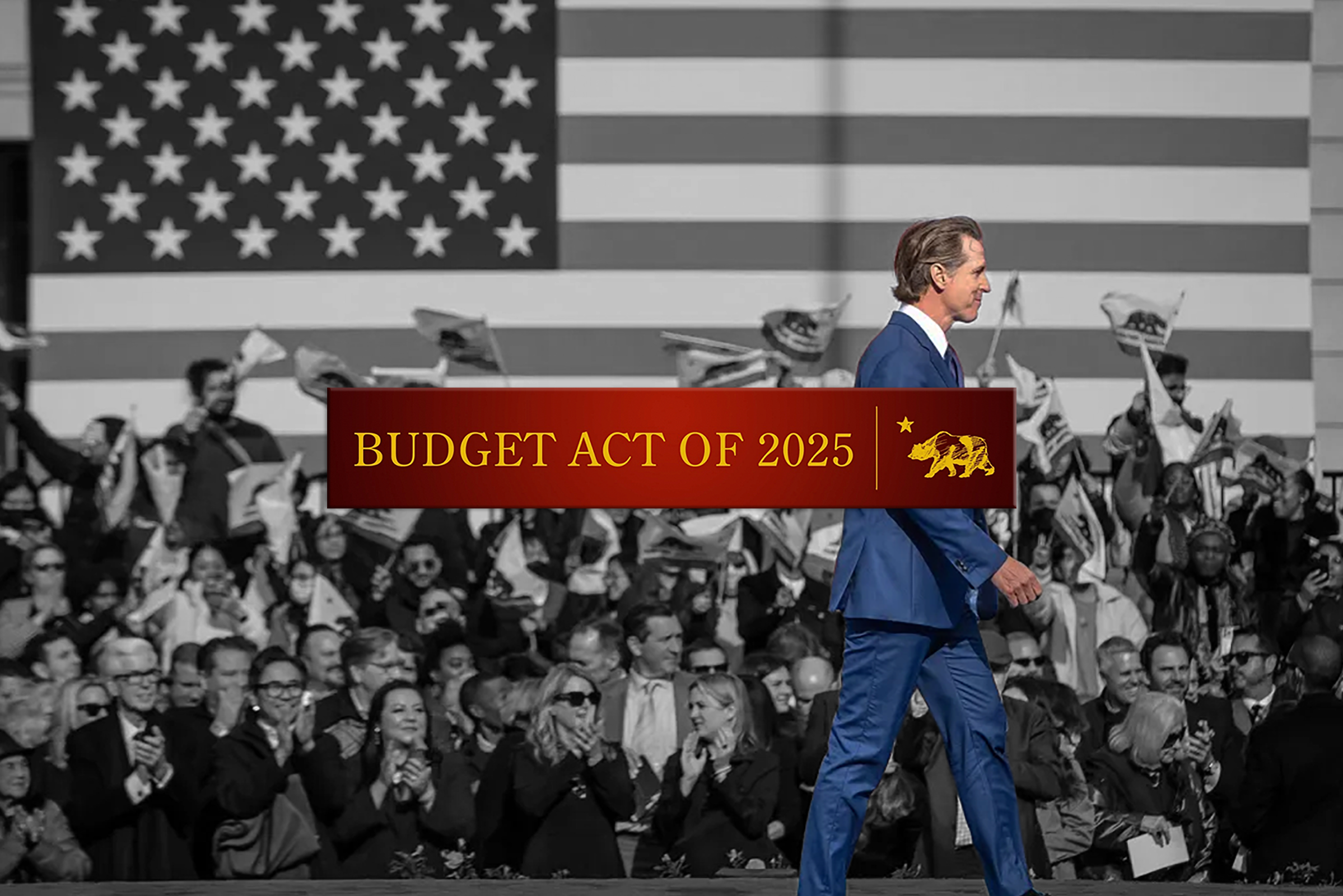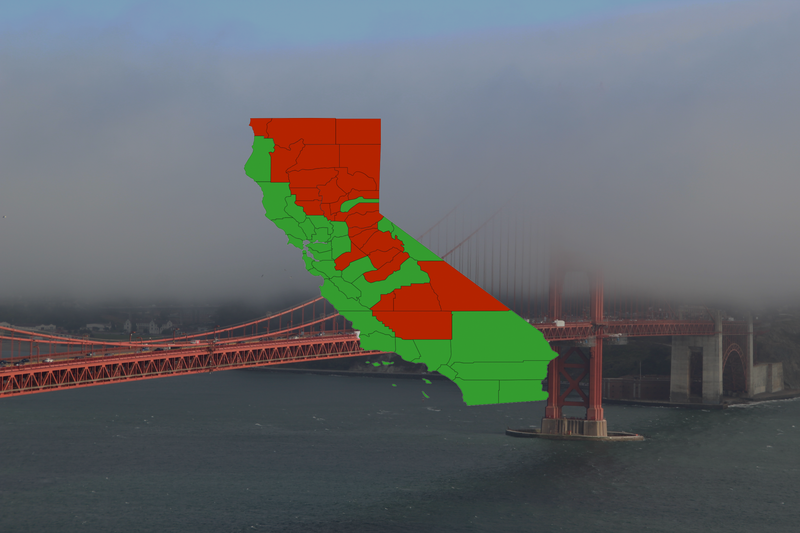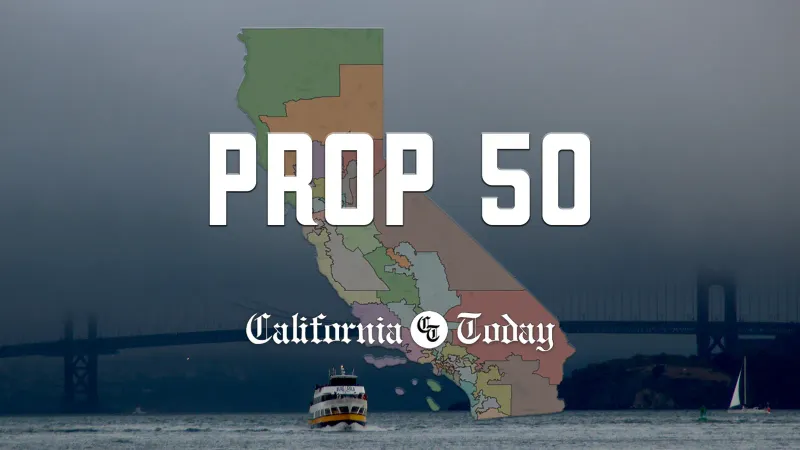2025-26 California state budget guide: What’s funded, what’s cut, and what’s kicked down the road
Despite facing a multibillion-dollar deficit, California’s 2025 budget deal promises to preserve essential services, support schools, and tackle homelessness. But beneath the surface, lawmakers have deferred payments, trimmed programs, and counted on optimistic forecasts to make the numbers work.
Now finalized and available to the public, California’s 2025-26 state budget reflects a high-stakes balancing act between fiscal restraint and political pressure—not unlike the budgets that preceded it during past shortfalls.
In an official budget summary release by the California Senate, lawmakers tout the final deal as a win for core priorities like education, housing, and healthcare, and in some ways, it is. But they also leaned heavily on one-time solutions, fund transfers, and payment delays that paper over deeper structural gaps.

This year’s budget process was shaped by falling tax revenues and rising costs across nearly every sector. In response, legislative leaders and Governor Gavin Newsom negotiated a deal that closes the shortfall without sweeping cuts to headline programs—but not without tradeoffs.
What’s in the California 2025 Budget?
Below, we use the official budget summary published by the California Senate Budget and Fiscal Review Committee to review the new major sections of the new agreement—including education, health, housing, and public safety.
Education (TK–12)
The 2025 California Budget Act allocates $114.6 billion in state funding for TK–14 education (transitional kindergarten through community college) under Proposition 98 for the 2025–26 fiscal year. This reflects a slight shortfall from the previous year's $120 billion minimum guarantee, leading to a $1.9 billion “settle-up” payment to be made in 2026–27. That funding will help cover ongoing school costs and reduce previous payment deferrals.
In addition to this core funding:
- The state is fully funding its Local Control Funding Formula, which determines how districts receive money, and is applying a 2.3% cost-of-living increase.
- To help districts manage costs, the state is withdrawing $405.3 million from its education Rainy Day Fund.
- A $1.9 billion deferral will delay some payments from June to July of 2026–27.
Several one-time grants were approved to support students and teachers:
- $1.7 billion for general student support.
- $378 million for learning recovery, following pandemic-related disruptions.
- $300 million for teacher stipends and consolidated credentialing support.
- $160 million to expand school meal programs, with $10 million earmarked for hiring and keeping nutrition staff.
- $200 million for teacher training in literacy instruction.
- $150 million for career technical education (pending legislation), which will be redirected if no law is passed by 2026.
- Additional one-time investments include $70 million for teacher residency and $30 million for math teacher development.
The budget also expands eligibility for after-school and summer programs, lowers access thresholds for high-need districts, and sets new per-student rates. The Special Olympics will receive $30 million, and $20 million will fund a new behavioral health support program.
Finally, the budget includes $1.8 million in wildfire recovery funding for impacted schools, and provides $20 million in emergency loan authority to Plumas Unified School District. Protections are also in place to shield wildfire-impacted districts from funding losses tied to enrollment dips or local property tax shortfalls.
In sum, the budget focuses on stabilizing the education system after pandemic- and disaster-related disruptions, addressing equity, and supporting both immediate recovery and long-term workforce pipelines in education.
Higher Education
The UC and CSU systems avoided proposed 3% cuts but face funding deferrals into 2026–27 and 2028–29. California Community Colleges will see over $200 million in targeted one-time support, including emergency aid and job training, while some capital and tech projects were quietly shelved.
The 2025 California state budget makes several key funding and policy decisions affecting public higher education, with a focus on community colleges, the University of California (UC), and California State University (CSU) systems.
Community Colleges (CCC)
To manage future budget shortfalls, the state is deferring $408 million in CCC funding from 2025–26 to 2026–27—less than the originally proposed $531.6 million. It’s also scaling back two large tech investments:
- Canceling the CCC’s Collaborative ERP project to save $168 million.
- Reducing funding for a new Common Cloud Data Platform, saving $150.5 million, while retaining $12 million for limited development.
The budget includes multiple one-time investments for California Community Colleges:
- $100 million to support 2024–25 enrollment growth.
- $60 million for a Student Support Block Grant.
- $20 million in emergency student financial aid.
- $6.3 million to reimburse firefighter apprenticeships.
- $15 million for Dream Resource Liaisons.
- $5.1 million for financial aid outreach.
- $5 million in career education grants for areas affected by the Los Angeles wildfires.
- $25 million for a new Career Passports Initiative, with added reporting requirements.
- $15 million one-time and $5 million ongoing to support Credit for Prior Learning programs.
University of California (UC) and California State University (CSU)
The Legislature rejected Governor Newsom’s proposal to permanently cut base funding for UC and CSU by 3% (worth over $273 million combined). Instead, those cuts are deferred to 2026–27, with access to zero-interest short-term loans to help bridge the funding gap.
Similarly, the budget delays a 5% Compact funding increase originally set for 2025–26:
- 2% will be paid in 2026–27:
- $96.3 million for UC
- $100.9 million for CSU
- The remaining 3% is deferred to 2028–29:
- $144.5 million for UC
- $151.4 million for CSU
Student Financial Aid
A major improvement was made to the Middle Class Scholarship program, which previously had unpredictable award amounts. Going forward, awards will be set annually, with 35% of the total eligible need funded in the latest budget. The Student Aid Commission will be funded based on cash flow needs to distribute awards more reliably.
Proposition 98 and Transitional Kindergarten
While the Legislature rejected the Governor’s earlier plan to shift TK funding out of Proposition 98 for 2023–24 and 2024–25, that shift will begin in 2025–26, effectively returning $260 million in ongoing funding to the community colleges.
Health
The 2025 California state budget introduces sweeping changes to the Medi-Cal program and public health spending, aiming to reduce long-term costs while maintaining key health services for vulnerable populations.

Read our full breakdown of the 2025-26 California health budget here.
Medi-Cal Restructuring and Savings
To manage ballooning health care costs, the Legislature enacted or modified several major Medi-Cal changes:
- Asset Limit for Eligibility: Instead of reverting to the pre-pandemic $2,000 cap, the state is setting the Medi-Cal asset limit at $130,000, saving $45 million in 2025–26 and up to $510 million annually going forward.
- Exclusion of Weight-Loss Drugs: Specialty drugs for weight loss will no longer be covered, saving $85 million in 2025–26, growing to $680 million annually by 2028–29.
- Loan Payment Delay: The state adds $1 billion to the Governor’s proposed $3.4 billion delay in Medi-Cal payments, pushing liabilities into future budgets.
A key cost-saving measure was a modified enrollment freeze for undocumented individuals:
- Starting January 1, 2026, undocumented adults aged 19 and older will be paused from enrolling.
- There’s no age-out clause, and a 6-month re-enrollment window is included.
- This policy saves $86.5 million in 2025–26, rising to $3.3 billion annually once fully implemented.
The state also modified proposed Medi-Cal premiums for certain undocumented immigrants (UIS):
- Monthly premiums will be $30 (instead of $100), only apply to ages 19–59, and begin in July 2027.
- This shift will cost $30 million in 2026–27, but eventually save $675 million annually.
Other major Medi-Cal actions include:
- Prescription Drug Rebates: Expanding the rebate system for undocumented populations saves $370 million in 2025–26 and $600 million annually.
- MCO Tax Offsets: Proposition 35’s managed care organization tax provides $1.3 billion in General Fund savings in 2025–26.
Delays to Governor’s Proposed Cuts
Several proposed cost-cutting measures were delayed:
- $362 million in dental care payments and cuts to dental benefits for UIS will now take effect July 1, 2026.
- $1.1 billion in cuts to health centers and rural clinics are also delayed until mid-2026.
Rejected Cuts
The Legislature rejected several proposed rollbacks to public health and reproductive services:
- A $172 million cut to family planning and women’s health services (with up to 90% federal matching) was rejected.
- Cuts to long-term care and in-home supportive services for undocumented adults were also rejected.
- The budget preserves nearly $60 million in unspent public health funds, protecting programs such as:
- The California Reducing Disparities Project
- Grants for LGBTQ+ foster youth and LBTQ women’s health
- Reproductive health justice
- STD/Hepatitis C prevention
- Public health workforce development
Future Employer Contribution Plan
The Senate will begin developing legislation to require large employers to contribute financially when their employees are enrolled in Medi-Cal instead of receiving employer-sponsored insurance. The plan could start as early as 2027–28, though it will require future budget action.
In summary, the 2025 health budget achieves billions in long-term Medi-Cal savings through enrollment changes, coverage exclusions, and program delays—while maintaining critical reproductive health and public health equity programs that lawmakers deemed untouchable.
Human Services
California is taking a mixed approach to human services, preserving core safety net programs while implementing some cost-saving reforms—particularly in developmental services and In-Home Supportive Services (IHSS). Major cuts proposed by the Governor were largely rejected in favor of maintaining support for vulnerable populations.
Cost-Saving Measures and Modifications
The Legislature approved several modified cost-saving strategies, largely focused on developmental services and IHSS:
- Developmental services providers must now meet specific quality benchmarks to receive incentive payments, achieving $221.7 million in savings.
- A planned financial cushion (“hold harmless”) for providers at Porterville Developmental Center is being reduced, saving $75 million.
- Spending at Porterville is being better aligned with actual costs, resulting in an additional $25 million in savings.
- The state will share penalties with counties in 2025–26 for late IHSS reassessments, then fully shift those penalties to counties in 2026–27, saving $41 million.
- Funding for the Family Urgent Response System (FURS) was partially reduced—cut by $9 million, but not eliminated.
Rejected Cuts and Program Protections
The Legislature rejected many of the Governor’s more severe proposals, protecting access to critical services:
- A proposed cap on overtime hours for IHSS providers was rejected.
- The Governor’s plan to eliminate IHSS for undocumented Californians was also rejected.
- The Foster Care Tiered Rate Structure and the expansion of the California Food Assistance Program (CFAP) were kept under the Legislature’s control, not subject to automatic “trigger cuts.”
- Funding for the Direct Service Professional Workforce Training and Development program was fully restored.
Restored and New Funding
The final budget restores and expands funding for multiple human services programs aimed at reducing hunger, supporting foster youth, and aiding vulnerable populations:
- CalFood: $52 million restored for emergency food support.
- CalFresh Fruits and Vegetables: $36 million restored to improve nutrition for low-income families.
- Home Safe: $81 million restored to help protect at-risk adults in the foster care or adult protective services systems.
- Bringing Families Home: $83 million restored for housing services tied to the child welfare system.
- Housing and Disability Advocacy Program: $45 million restored to support seniors and people with disabilities in finding stable housing.
- Foster Family Agencies: $31.5 million in bridge funding (including $23 million General Fund) to prevent closures and maintain federal matches.
- Children’s Holistic Representation Project: $10 million restored to continue integrated legal and social support for unaccompanied minors.
- One California Immigration Legal Services: $10 million added, on top of $75 million in ongoing support, plus an extra $10 million from a special session bill (SBX1-2).
- Diaper Bank Network: $7.4 million provided to distribute diapers and wipes to low-income families.
In short, the 2025 budget for human services balances modest program adjustments with substantial protections. While some savings are realized through efficiency measures, lawmakers prioritized housing, food security, legal aid, and essential care services for the most vulnerable Californians.
Child Care and Preschool
targeted adjustments to stabilize the state’s child care and preschool systems, focusing on provider funding and payment reforms rather than broad cuts.
Program Adjustments and Savings
- The Legislature scaled back a proposed funding cut to the Emergency Child Care Bridge Program, which helps foster children access child care. Instead of reducing the program by $42.7 million as proposed by the Governor, lawmakers reduced it by $30 million, preserving critical support for foster families.
Funding Reallocations and Provider Support
- A planned suspension of $70 million in cost-of-living adjustment (COLA) funds was reversed. Instead, that money will now be used to provide a rate increase for all subsidized child care and preschool providers, helping stabilize operations across the state.
Payment System Reform
- The budget also implements prospective pay based on enrollment for all child care providers. This means providers will be paid in advance based on expected enrollment, rather than attendance, improving cash flow stability and reducing financial uncertainty for providers.
In summary, the 2025 budget prioritizes rate increases, stable payments, and partial restoration of cuts in the child care and preschool sector—aiming to support providers while maintaining access for families, especially those involved in the foster care system.
Housing and Homelessness
Significant investment in housing and homelessness solutions are evident in the new budget, which combines major new funding with policy reforms to accelerate affordable housing production and enhance accountability at the local level.
Targeted Savings
- The state will sweep $31.7 million in unspent funds from three affordable housing programs, as proposed by the Governor, to help address the budget deficit.
Major Investments in Housing and Homelessness
- $500 million is allocated to continue the Homeless Housing, Assistance, and Prevention (HHAP) program, which gives local governments flexible tools to address homelessness with built-in accountability systems.
- $100 million goes to the Encampment Resolution Fund, aimed at helping cities and counties move unhoused residents from encampments into more stable settings.
- An additional $500 million in Low-Income Housing Tax Credits will help finance affordable housing projects by attracting private investment.
- $300 million supports the California Dream for All program, which offers shared appreciation loans for first-time, first-generation homebuyers, helping reduce barriers to homeownership.
- $120 million is provided for new deeply affordable housing units through the Multifamily Housing Program.
Tax Relief and Oversight Enhancements
- The budget adopts reforms to the Renter’s Tax Credit, though actual funding will depend on future appropriations.
- It also funds the expansion of the Housing and Homelessness Accountability, Results, and Partnership (HHARP) unit, giving the Housing and Community Development Department (HCD) more tools to enforce local compliance with state housing laws.
Streamlining and Policy Reforms
To accelerate housing construction and reduce red tape, the budget includes a wide-ranging set of budget trailer bills that modernize land-use policies and environmental reviews:
- CEQA streamlining measures from bills like SB 607 (Wiener) and AB 609 (Wicks) will allow faster development in appropriate areas while protecting sensitive land.
- SB 681 (Wahab) introduces a suite of affordability reforms, including:
- Limits on HOA penalties
- Limits on appeals to Coastal Commission housing approvals
- Protections from “zombie mortgages”
- Permanent extensions of certain housing efficiency laws
- AB 306 (Rivas/Schulz) prevents unnecessary changes to building codes from October 2025 through June 2031, ensuring predictability for developers.
- A new Vehicle Miles Traveled (VMT) mitigation bank will allow developers to invest in transit-friendly affordable housing as a way to offset environmental impacts.
- The budget also allows affordable housing developers receiving state funds to leverage equity in existing projects to finance new ones, under strict guidelines.
In summary, the 2025 housing and homelessness budget blends immediate financial support for housing programs with long-term structural reforms, aiming to speed up housing development, strengthen local accountability, and expand access to both rental and homeownership opportunities across California.
Resources, Energy, and Climate
The 2025 California Budget Act includes major funding shifts and reductions across energy, climate, and wildfire response programs, with a strong emphasis on managing the state’s ongoing budget deficit while preserving long-term environmental commitments.
Spending Reductions and Fund Shifts
To help close the state’s budget gap:
- The Community Renewable Energy Program is being cut by $33 million.
- $35 million is being redirected to clean up lead-acid battery contamination from the Exide site, moved into the Lead-Acid Battery Cleanup Fund.
- $31.4 million earmarked for purchasing land for a CalFire training center is being returned to the state.
- A significant $1 billion reduction is being applied to the 2025–26 Greenhouse Gas Reduction Fund (GGRF) discretionary spending plan.
The budget also outlines contingency plans for future CalFire funding:
- If the General Fund remains in deficit, CalFire will receive:
- $1.25 billion from the GGRF in 2026–27,
- $500 million in both 2027–28 and 2028–29.
- If the deficit resolves, CalFire would only receive $500 million in 2026–27.
In addition:
- The state is reverting $315.8 million in unused funds from past climate and energy packages.
- However, it preserves a previously threatened $351.7 million allocation for water resilience and habitat restoration projects in the Sacramento–San Joaquin Delta, funding efforts tied to the Voluntary Agreements.
New and Ongoing Investments
Despite broad cuts, several targeted investments remain:
- $39 million in 2025–26 and $78 million ongoing are allocated to make CalFire seasonal positions permanent, strengthening fire readiness.
- $9.5 million will support the California Fire Safe Council’s Wildfire County Coordinator Program, which assists local wildfire mitigation efforts.
- $132.2 million is provided for the Hybrid and Zero-Emission Truck and Bus Voucher Incentive Project (HVIP), encouraging cleaner commercial transportation.
- $2 million goes to the Wolf-Livestock Compensation Program, administered by the Department of Fish and Wildlife, to offset rancher losses from wildlife protections.
Policy Rejections
The Legislature rejected the Governor’s proposal for environmental fast-tracking via trailer bills related to:
- The Delta Conveyance Project, and
- A CEQA exemption for parts of the Bay-Delta Plan.
In summary, the 2025 budget trims or defers several major climate and energy initiatives to address fiscal constraints, while preserving critical wildfire funding, clean vehicle incentives, and select conservation programs in regions most impacted by environmental challenges.
Public Safety and Judiciary
The 2025 California state budget takes a mixed approach to human services, preserving core safety net programs while implementing some cost-saving reforms—particularly in developmental services and In-Home Supportive Services (IHSS). Major cuts proposed by the Governor were largely rejected in favor of maintaining support for vulnerable populations.
Cost-Saving Measures and Modifications
The Legislature approved several modified cost-saving strategies, largely focused on developmental services and IHSS:
- Developmental services providers must now meet specific quality benchmarks to receive incentive payments, achieving $221.7 million in savings.
- A planned financial cushion (“hold harmless”) for providers at Porterville Developmental Center is being reduced, saving $75 million.
- Spending at Porterville is being better aligned with actual costs, resulting in an additional $25 million in savings.
- The state will share penalties with counties in 2025–26 for late IHSS reassessments, then fully shift those penalties to counties in 2026–27, saving $41 million.
- Funding for the Family Urgent Response System (FURS) was partially reduced—cut by $9 million, but not eliminated.
Rejected Cuts and Program Protections
The Legislature rejected many of the Governor’s more severe proposals, protecting access to critical services:
- A proposed cap on overtime hours for IHSS providers was rejected.
- The Governor’s plan to eliminate IHSS for undocumented Californians was also rejected.
- The Foster Care Tiered Rate Structure and the expansion of the California Food Assistance Program (CFAP) were kept under the Legislature’s control, not subject to automatic “trigger cuts.”
- Funding for the Direct Service Professional Workforce Training and Development program was fully restored.
Restored and New Funding
The final budget restores and expands funding for multiple human services programs aimed at reducing hunger, supporting foster youth, and aiding vulnerable populations:
- CalFood: $52 million restored for emergency food support.
- CalFresh Fruits and Vegetables: $36 million restored to improve nutrition for low-income families.
- Home Safe: $81 million restored to help protect at-risk adults in the foster care or adult protective services systems.
- Bringing Families Home: $83 million restored for housing services tied to the child welfare system.
- Housing and Disability Advocacy Program: $45 million restored to support seniors and people with disabilities in finding stable housing.
- Foster Family Agencies: $31.5 million in bridge funding (including $23 million General Fund) to prevent closures and maintain federal matches.
- Children’s Holistic Representation Project: $10 million restored to continue integrated legal and social support for unaccompanied minors.
- One California Immigration Legal Services: $10 million added, on top of $75 million in ongoing support, plus an extra $10 million from a special session bill (SBX1-2).
- Diaper Bank Network: $7.4 million provided to distribute diapers and wipes to low-income families.
In short, the 2025 budget for human services balances modest program adjustments with substantial protections. While some savings are realized through efficiency measures, lawmakers prioritized housing, food security, legal aid, and essential care services for the most vulnerable Californians.
Transportation
The 2025 California Budget Act protects public transit from deep funding cuts while providing urgent support to struggling regional systems—particularly in the Bay Area.
Major Rejected Cuts
- Lawmakers rejected the Governor’s proposed $1.1 billion cut to state transit programs, preserving long-term investment in public transportation infrastructure and services.
Emergency Transit Relief
- The budget authorizes up to $750 million in emergency loans for Bay Area transit agencies to help them bridge short-term financial gaps. These loans are aimed at preventing service reductions and supporting system stability while agencies work toward long-term fiscal recovery plans.
The transportation budget maintains the state’s commitment to public transit by blocking large-scale cuts and offering targeted emergency aid to keep systems—especially in the Bay Area—running and accessible for Californians.
Labor
For labor issues, the the new budget balances short-term fiscal needs with selective investments in worker protections and program expansions, while postponing a broader restructuring of the state workforce.

Read our full breakdown of the 2025-26 California labor budget here.
Key Budget Actions
- The Legislature approved a $400 million loan from the Labor and Workforce Development Fund to the General Fund, helping offset the state’s budget deficit.
Worker Protections and Program Expansion
- $8.5 million in one-time funding is allocated for a new Garment Worker Center Pilot Project, including a study to evaluate its effectiveness in supporting garment industry workers.
- $13 million is allocated to expand the California Workplace Outreach Program, which helps educate workers—especially in underserved communities—about their rights and available labor protections.
Vacant Positions and Fiscal Savings
- A proposal to eliminate 6,002 vacant state positions has been postponed until the 2026 budget cycle. This delay allows more time to assess the impact such cuts could have on state services related to public health, safety, environmental protection, and newly passed legislation.
- Despite the delay, the budget still captures $182 million in savings for 2025–26 by keeping these positions unfilled for now.
In short, the labor budget supports critical worker programs and maintains regulatory flexibility while contributing to deficit reduction through internal fund transfers and temporary staffing freezes.
General Government
Statewide infrastructure, workforce development, and local communities will all see significant investment in the new budget, while implementing targeted tax reforms and rejecting some of the Governor’s proposed cuts to arts and planning initiatives.
Key Rejected Proposals
- The Legislature rejected a proposed $11.5 million cut to the Performing Arts Equitable Payroll program, preserving funding for fair wages in arts employment.
- A proposed $2 million allocation for Capital Outlay Planning and Studies was also rejected.
Major One-Time and Ongoing Investments
- $100 million is allocated to further implement the Downtown Fresno Infrastructure Plan, supporting revitalization and economic development.
- $25 million is dedicated to supporting capital costs for the new National Semiconductor Technology Center facility in Sunnyvale.
- $17 million extends the California Regional Initiatives for Social Enterprises (CA RISE) program by two years, supporting transitional employment for justice-involved individuals.
- The budget invests in youth, education, and community service programs:
- $5 million in 2025–26 and $84 million annually thereafter to expand and make permanent the CalVolunteers College Corps.
- $7.5 million for the SEED Initiative to support guaranteed income pilot programs.
- $5 million for the California Student Success Coach program.
- $5 million for a statewide “Belonging Campaign” to foster social cohesion.
- $2 million for the Initiating Change in Our Neighborhoods (ICON) program.
Tax and Revenue Changes
- The budget adopts a single sales factor formula for financial institutions, expected to generate $330 million in new General Fund revenue in 2025–26.
- A Legislative Analyst’s Office (LAO) review will explore long-term tax reform options aimed at reducing taxes for working families while preserving state revenue and federal deductibility.
- The Legislature approved a package of tax-related changes, including:
- Extending the pass-through entity elective tax
- Expanding the Film Tax Credit
- Providing a military retirement income exemption
- Reforming the Renter’s Tax Credit, especially for renters with dependents (subject to future funding)
- Expanding the wildfire settlement tax exclusion retroactively to 2021
- Restoring $10 million to the HOPE savings account program for children, softening the Governor’s proposed $50 million cut to $40 million
Government Operations and Oversight
- $20 million is allocated to the Department of Finance to hire consultants and improve state government efficiency, with oversight by the Legislature.
- The budget shifts enforcement funding for the Department of Cannabis Control from the Cannabis Control Fund to the Cannabis Tax Fund, a move aimed at long-term funding sustainability.
Local and Community Investments
- $12.5 million is approved for community home hardening and wildfire risk mitigation efforts, including residential risk assessments.
- $79 million in one-time funding will backfill a Vehicle License Fee shortfall for local governments.
- $2.5 million supports the Historic South Los Angeles Black Cultural District.
- $1.5 million funds a new interagency entity to coordinate education and workforce development planning.
- $819,000 is restored for deferred maintenance at California Veterans Homes, providing long-term support for veteran services.
In total, the 2025 general government budget supports local revitalization, cultural preservation, tax modernization, and community-focused programs, while pushing back on cuts to arts and planning and reinforcing California’s broader commitments to equity, efficiency, and fiscal responsibility.
Behind the Budget Spin: 3 Real Examples
While the 2025 budget includes real investments and program protections, some of the language used in official summaries masks the true impact of policy choices. Here are three examples where the framing softens the blow:
1. “Repurposes $70 million…”
Official language: “Repurposes the $70 million in cost-of-living adjustment funds proposed to be suspended, and instead provides $70 million for a rate increase…”
What’s happening: This makes it sound like child care providers are getting a bonus. In reality, the budget eliminates a planned cost-of-living adjustment and simply redirects the same funds to a different form of payment—avoiding new spending, not adding support.
2. “Sweeps the remaining unspent balances…”
Official language: “Approves Governor’s proposal to sweep the remaining unspent balances in three affordable housing programs funds to achieve $31.7 million in savings.”
What’s happening: “Sweeping unspent funds” sounds like good housekeeping, but it’s a euphemism for pulling funding out of housing programs that were previously approved. In a state facing a housing crisis, this decision slows down the pipeline of future affordable units.
3. “Modifies Governor’s proposal to reduce…”
Official language: “Modifies Governor’s proposal to reduce Family Urgent Response System (FURS) by decreasing reduction to $9 million.”
What’s happening: The phrase “modifies” makes this sound like a win—but the program is still being cut by $9 million. The language highlights what was saved from deeper cuts instead of acknowledging what’s being lost.
These examples reflect a broader pattern across the 2025 budget: framing decisions as “restorations,” “modifications,” or “repurposings” to minimize public backlash and preserve the appearance of stability—even when the underlying policy is a reduction, deferral, or rollback.
Final Word: Stability Now, Uncertainty Later
The 2025 budget succeeds in avoiding immediate disruption, but it relies on loans, deferrals, and policy delays that kick tough decisions down the road. With future liabilities already built in—especially in Medi-Cal, education, and transit—next year’s budget could face even greater pressure unless revenue rebounds sharply.
Each of the sections above will be covered in depth in a series of follow-up articles designed to show not just what lawmakers passed—but what it means for Californians who rely on these services.









